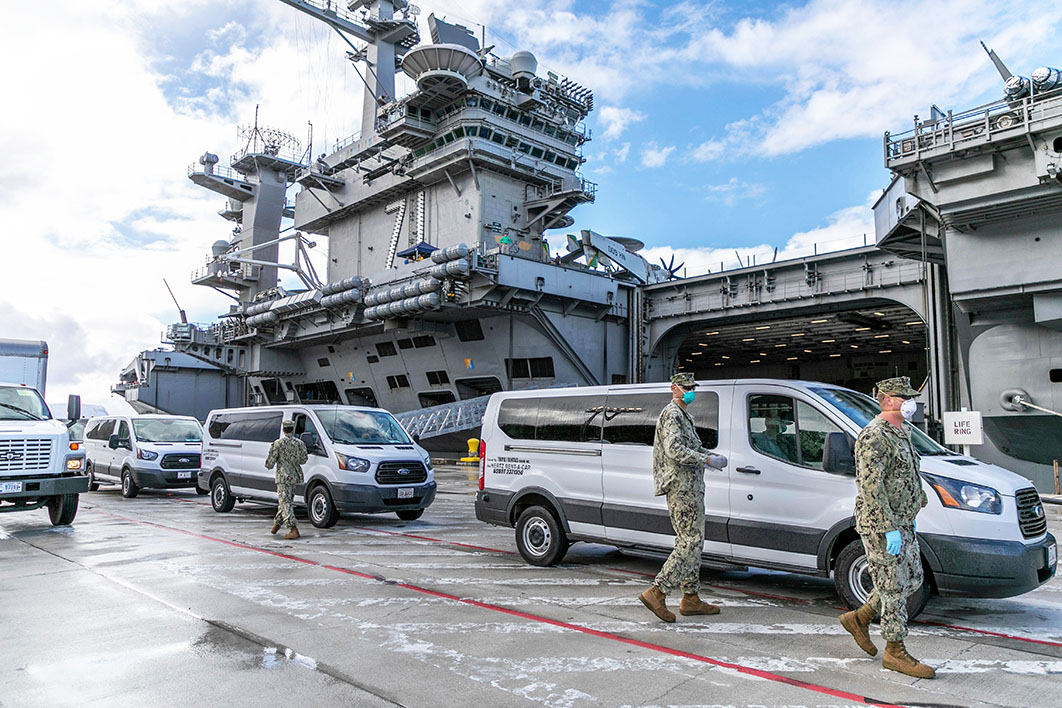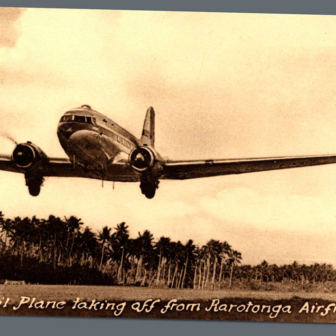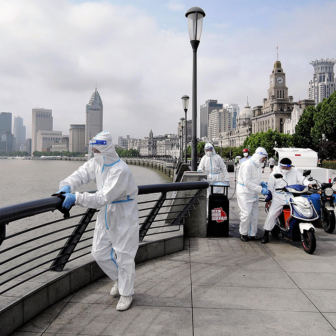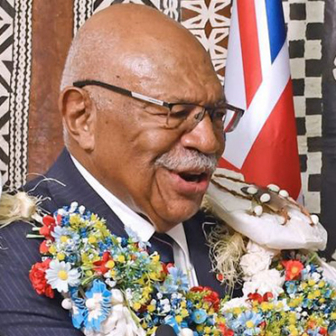Back in 1907, American president Theodore Roosevelt dispatched an armada of battleships, “the Great White Fleet,” to circumnavigate the globe. The tour was designed to demonstrate hegemony over the Pacific Ocean without firing a single shot. Less than a decade before, a victorious US military had taken control of Spanish colonies including Puerto Rico, Cuba and the Micronesian island of Guam.
Nowadays, despite rising Chinese influence in the region, the US Seventh Fleet maintains American naval dominance in the Pacific. And one of its largest nuclear-powered aircraft carriers is the USS Theodore Roosevelt, a vessel whose firepower reflects Roosevelt’s foreign policy maxim: “Speak softly and carry a big stick.”
Today, this aircraft carrier — together with Roosevelt’s latest successor, Donald Trump, and the 170,000 people of Guam — is tangled up in the coronavirus pandemic. It’s a tale that highlights the militarisation of this American territory and the lack of security experienced by Pacific islanders under colonial administration.
The Theodore Roosevelt arrived in Guam last month after visiting Vietnam. Authorities now believe a number of the carrier’s 5000 crew members had been infected with SARS-CoV-2 during shore leave in Vietnam. By late March, more than a hundred sailors had been diagnosed with Covid-19. The aircraft carrier held only around 800 testing kits, but the Pentagon announced it would fly in enough kits for everyone aboard.
Anchored off Guam, the warship’s commanding officer, Captain Brett Crozier, sought permission to put nearly 3000 sailors onshore in order to limit the rate of infection in the cramped below-deck quarters (a hazard on cruise ships around the world, as we’ve seen recently). “This will require a political solution but it is the right thing to do,” Crozier wrote to US Indo-Pacific Command in Hawaii. “We are not at war. Sailors do not need to die. If we do not act now, we are failing to properly take care of our most trusted asset — our sailors.”
To the anger of the Pentagon and the White House, the memo was leaked to the San Francisco Chronicle. On 1 April, Crozier was relieved of his command. As one Washington Post columnist commented, “The only official in the entire government who has been publicly disciplined to date for mishandling the coronavirus is a navy officer who acted to save his crew from an outbreak. This makes no sense save in the upside-down moral universe inhabited by the Trump administration.”
With the US presidential election scheduled for November, Captain Crozier’s removal quickly became politicised. According to Democrat contender Joe Biden, “Donald Trump’s acting navy secretary shot the messenger — a commanding officer who was faithful to both his national security mission and his duty to care for his sailors, and who rightly focused attention on a broader concern about how to maintain military readiness during this pandemic.”
So far, 155 Covid-19 cases have been confirmed among the crew of the carrier, with sailors who test positive being transported to the US Naval Hospital on Guam. But the furore in the US media has largely focused on the impact of these events on the US military and Captain Crozier, who has since been diagnosed with Covid-19 himself. Little, if any, attention has been given to the indigenous Chamoru people, who make up 40 per cent of the population of the island they call Guåhan.
Despite a rising number of cases, Donald Trump waited until 28 March to make a major disaster declaration for Guam, finally opening the way for federal assistance to the territory government and local non-profit organisations. The territory’s health service is already stretched by 112 confirmed diagnoses, and the decision to move thousands of US sailors into local hotels angered many residents. The Guam government had turned away the cruise ship MS Westerdam in February, fearful of a spread of Covid-19 from infected passengers, but Guam has no authority to block a US warship from its harbours.
Coming under the mandate of the UN Special Committee on Decolonisation, Guam was first listed as a UN Non-Self-Governing Territory in 1946. That territorial status means Guam’s residents lack effective representation in Washington. As American citizens, they can vote in this November’s presidential election, but with Guam holding no votes in the US electoral college it is effectively a straw poll. Guam’s membership of the US Congress also lacks force: Michael San Nicolas might sit as the territory’s delegate in the US House of Representatives, but Guam’s political status means he doesn’t have full voting rights.
“This century has been called the Pacific Century due to a noticeable shift in power from the Atlantic Rim to the Pacific Rim,” writes Chamoru academic Michael Lujan Bevacqua, co-chair of Independent Guåhan, which promotes the case for independence. He believes this has fuelled a renewed American interest in militarising Guam.
“We see other Pacific nations working to develop partnerships with countries around the world,” he says, but Guam’s status means it can’t take advantage of the shift. “We should reject remaining a colony. To advocate for status quo means to accept the idea people on Guam are different than everyone else.”
The Guam Commission on Decolonisation, which has been working towards a plebiscite on self-determination, has mounted an education campaign centring on three options for future governance, including independence, but progress has been slow after the US Court of Appeal ruled that a planned plebiscite could not proceed if it is limited to “native inhabitants” of Guam.
Despite a rising number of Covid-19 infections, Guam’s governor, Lourdes Leon Guerrero, has been measured in her criticisms of American policy. Leon Guerrero and Representative San Nicolas are both members of the Democratic Party, and thus face a high risk of political backlash from the White House.
They are also likely mindful of President Trump’s hostile reaction to criticism from local officials in Puerto Rico, another US territory, after Hurricane Maria devastated the island in 2017. In the aftermath of the Category 5 hurricane, President Trump shamefully abused San Juan mayor Carmen Yulín Cruz, who had criticised Washington’s “slow and inadequate” response. After nearly 3000 deaths, local residents were appalled when Trump visited the island and announced his main concern: “I hate to tell you Puerto Rico, but you’ve thrown our budget a little out of whack, because we’ve spent a lot of money on Puerto Rico, and that’s fine.”
Local women’s and community organisations in Guam are angered that the US government isn’t matching its care for the infected military personnel with support for the local community. “The hospital I work in, we only have fourteen ICU beds — the other civilian hospital has even less,” says Pim Limtiaco, a health worker at one of only two civilian hospitals in Guam. “We may not have enough beds to ventilate those that are very critical.”
Limtiaco tells me there may come a time where hard decisions need to be made about which patients get a ventilator: “It is already bad enough that we don’t have the manpower and resources. It’s very scary.”
A Westernised diet means that diabetes and other non-communicable diseases are already a major challenge for Guam’s hospitals, she says, and the increase in coronavirus infections could lead to more fatalities among existing patients: “You have to go to the root of the problem and look at why we have such levels of diabetes, through the introduction of colonial foods like Spam. We used to have a good diet: people farmed, we fished, we had taro and breadfruit.”
With a drop in international tourism, local businesses are eager for the US government to pay for the rehousing of crew members from the carrier in largely empty hotels. Sailors from the USS Theodore Roosevelt have been accommodated at the Hyatt, the Sheraton Laguna Guam Resort and other luxury hotels in Tamuning, Tumon and other tourist districts. But community groups would prefer they were staying in the island’s US military bases, including the Apra Harbor Naval Base in Santa Rita and Andersen Air Force Base in Yigo.
Concerned about the reluctance of their politicians to take a strong public stand over the USS Theodore Roosevelt, Chamoru groups have been calling for action. On 1 April, with the support of seven other local community organisations, the Chamoru women’s organisation I Hagan Famalåo’an Guåhan wrote to governor Leon Guerrero.
“We feel for the sailors aboard, but we don’t have the resources to give that can accommodate an outbreak that is growing so rapidly that the ship’s captain is pleading for more help from the Navy,” they wrote. “The governor must keep in mind that the average sailor aboard the USS Roosevelt is in their early twenties and are not considered an at-risk age group, while our large manamko [elderly] community are the most vulnerable to serious illness or death. A decision to house infected military personnel off-base is one that will impact the health and safety of us all, especially the immuno-compromised and our manamko.”
Despite controlling a third of Guam’s land mass, the US Department of Defense “has decided to use Tumon to house personnel from an infected vessel,” the letter went on. “Tumon is a central village where countless members of the local community are still working and living during this uncertain time… This puts our dedicated service workers in the hotel industry and their families at a higher risk.”
Pim Limtiaco shares the concern that quarantining thousands of sailors in upscale resorts increases the risk for everyone. “Just because they are negative now doesn’t mean they can’t get infected later,” she tells me. “That poses a risk not just to themselves but to the locals who are serving them, especially the hotel staff. These staff don’t have the proper protective equipment when they’re meeting the sailors or cleaning their rooms or preparing food. Because we have Covid-19 on Guam already, we also don’t know if locals will expose them as well.”
This crisis has caused debate and division in the community. Local businesses derive income from sailors and marines on rest and recreation, most Chamoru families have members serving in the US military, and Micronesian culture prides itself on hospitality to visitors. But even before the arrival of the aircraft carrier, people in the capital, Hagåtña, were angry that twenty US airmen who were meant to be in fourteen-day quarantine had travelled to work on US military bases.
“It’s already really hard at the local level because not everyone is taking the quarantine seriously, creating burdens to us here at the hospital,” said Limtiaco. “The military claim they are going to have very strict requirements for the sailors from the aircraft carrier. But there were already photos circulating in Guam proving that some US airmen are not following the existing quarantine laws. They show ten or more people gathering at the beach. I can only imagine how we can keep the military accountable for this, if already some of the branches are not following local laws.”
As she observes, the story of Captain Crozier and the aircraft carrier has made national and international headlines, “but Guam is like an asterisk. The captain saved 5000 sailors but at the expense of the local indigenous population.”
President Trump’s mixed messages about the pandemic have been echoed by the Pentagon, with officers under orders not to contradict White House pronouncements. In late February, according to the New York Times, US defense secretary Mark Esper urged American military commanders overseas “not to make any decisions related to the coronavirus that might surprise the White House or run afoul of President Trump’s messaging on the growing health challenge.”
As the crisis evolved, US chief of naval operations Admiral Mike Gilday sought to calm community anger: “Our two top priorities are taking care of our people and maintaining mission readiness. Both of those go hand in glove. We are confident that our aggressive response will keep USS Theodore Roosevelt able to respond to any crisis in the region.”
As they prepare for the RIMPAC 2020 wargames, scheduled for waters off Hawaii in June, US naval commanders are concerned that the crisis aboard the carrier signals wider problems. The ANZUS allies, concerned about China’s political influence in Pacific island nations, are eager to show they are in control.
But the USS Theodore Roosevelt debacle also raises fundamental questions about the health and wellbeing of people living in American and French colonial territories in the Pacific. With politicians in Paris and Washington consumed by domestic crises involving thousands of dead and millions of unemployed, the fate of populations in far-flung territories is not a central priority.
Nor is it any surprise that the Pacific islands with the highest rates of infection are all under colonial administration, lacking full control of borders, health budgets and political governance.
At time of writing, the independent nation of Fiji had fifteen confirmed cases of Covid-19 and Papua New Guinea just two, despite a combined population of nearly ten million. No other cases have been reported in independent nations in the region. By contrast, Hawaii had 387 cases with five deaths, and the US territory of Guam 112 with four deaths; and cases have been recorded in the US Commonwealth of the Northern Marianas (eight with two deaths) and the French collectivities of French Polynesia (forty-seven) and New Caledonia (eighteen).
Even the isolated Chilean territory Rapa Nui (Easter Island) has five cases. Local community leaders have tried to restrict overseas arrivals, but Chile’s health minister, Jaime Mañalich, announced that the government would reopen travel to the island after a short lockdown.
The pandemic will reshape international geopolitics. The Trump administration is already criticising Chinese president Xi Jinping for the authoritarian censorship that delayed the global response to the pandemic. But the crisis has revealed that both emperors have no clothes. Trump’s shortlived plans to open up the US economy by Easter just highlighted the folly of cost-cutting in health and welfare services.
The crisis also raises the obvious question about human security: what use are nuclear weapons and aircraft carriers when doctors don’t have enough beds for the sick and dying? •




